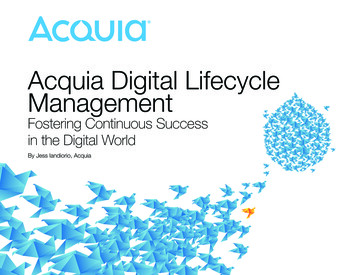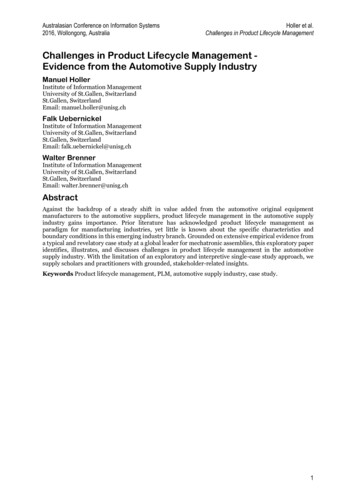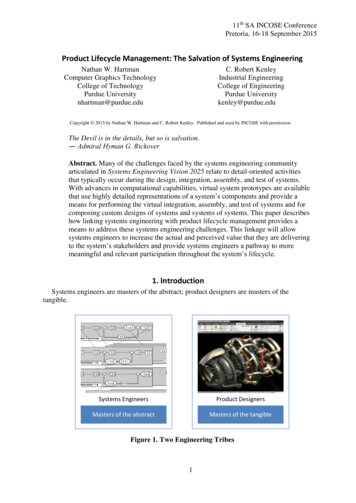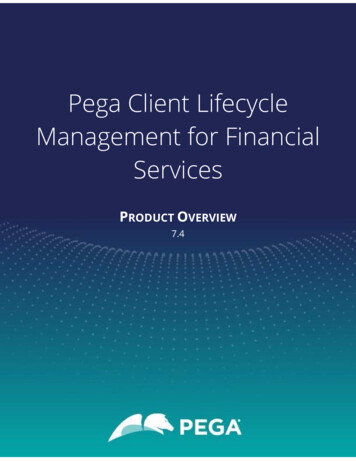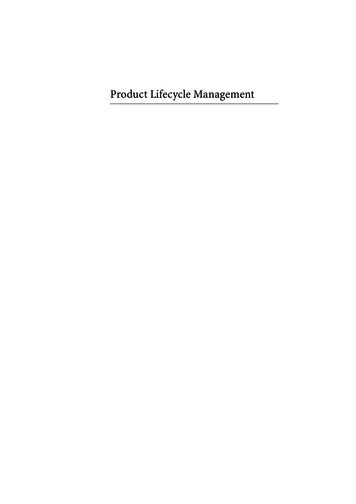
Transcription
DESIGN FOR PRODUCTLIFECYCLE MANAGEMENTWenlei Zhang'' , Yushun Fan ' Shenyang Institute of Automation, Chinese Academy of Sciences, Shenyang, P.R. China,'Gradute School of the Chinese Academy of Sciences, Beijing, P.R. China,zwl@sia.cnDept. of Automation, Tsinghua University, Beijing, P.R. China,fanyus@tsinghua.edu.cnProduct lifecyde management (PLM) is a concept that aims at integrating thevarious processes and stages involved during a typical product lij'ecycle for theextended enterprise. PLM technologies endeavor to offer a powerfulcollaborative platform to support distributed product development. In order tomaintain the integrity of product definition data throughout the life of theproduct, and to manage business processes used to create, manage,disseminate, share and use the information, this paper fust explores theconnotations of PLM; then presents a conceptual modeling frameworkincluding a four-tier-architecture; furthermore models product lifecyde in thestages of requirement analysis, conceptual design, engineering design,manufacturing and services; and finally proposes an integration framework tosupport interoperability of distributed product data sources.1. INTRODUCTIONThe Product Lifecyde Management (PLM) concept holds the promise of seamlesslyintegrating all the information produced throughout all stages of a product'slifecyde to everyone in an organization at every managerial and technical level.Most of global leading providers and consultant organizations of manufacturingautomation solutions, including UGS, IBM, PTC and CIMdata etc, consider PLM isthe key to collaboration and cooperation. "The strategy of PLM is to build upextended enterprise based on web and support all the suppliers, partners and trustedcustomers to capture, manage, evaluate and utilize all the related information." '''As the backbone of PLM approach, product information model enable thedescription, dissemination and sharing of product data in the distributedmanufacturing environment. So, the product modeling technologies have won theextensive recognition in both academia and industry. In the last two decades,product modeling technologies for specific stages have been enormously explored.Bidarra and Brownsvoort give the product engineering design models based onsemantic featuring modeling technology \ Jiao offers a generic bill-of-material andoperation (GBOMO) data model to manage variant product structures of the productfamily ' '.Simon presents a product lifecyde data acquiring technology (LCDA),which employs sensors and micro-processors to collect product operation processPlease use the foUmring format when citing this chapter:Zhang, W., Fan, Y, 2006, in IFIP International Federation for Information Processing, Volume 220, Information Technology for Balanced Manufacturing Systems, ed. Shen, W., (Boston; Springer), pp. 183-192.
184Information Technology for Balanced Manufacturing Systemsdata dynamically to build product operation data model ''''.Shehab etc. presents aknowledge-based intelligent product cost evaluation system, which helps designersevaluate product manufacturing cost ' '.With the increasing competition in the global market, the manufacturing industryneed make agile responds to changes of market. Modes of enterprises federation,web manufacturing and collaborative manufacturing demand enterprises adoptinformation technologies to maintain and management distributed product datauniformly '''I And product lifecycle model offers a conceptual mapping mechanismfor them to link data of product design, process, quality, cost, sales and operation.And it allows the related distributed data to be acquired and processed. TheAxiomatic Design (AD) method proposed by Suh is one such approach that providesa systematic lifecycle guideline for evaluating the acceptability of designs ''l In AD,the design process is considered a series of domains and their mappings, and thedomains mainly include: {CSs}, {FRs}, {DPs} and {PVs}. Jiao and Tseng furtherestablish the FBS-views product model '**', and the mappings among the views pushthe product variant design along the product lifecycle. And bill-of-materials canrepresent the product information by a common and simple data format''''"'. SingleSource of Product Data (SSPD) is presented to explore the logic relations of productdata, aiming to build a logic uniform data source of physically distributed productdata, so the access and operation of product data can be derived from the singlesource ' " I And web-based product lifecycle modeling technologies have beenbroadly researched'' '"'But PLM solutions stress that product data should be created, exchanged andshared across all the stages along the product lifecycle. And the definition andmanagement of a global product information model is the key to implement PLM.However, the above modeling technologies have been rare researched. So this paperdevotes to exploring the approaches of building an integrated, reconfigurable andconsistent product lifecycle information model, which is addressed by theframework of global PLM model, stage models and their evolution modes.2. THE PLM DEFINITION AND SYSTEM ARCHITECTURECIMdata gives the classic definition of PLM as: (1) A strategic business approachthat applies a consistent set of business solutions that support the collaborativecreation, management, dissemination, and use of product definition information; (2)Supporting the extended,j''T'' ,enterprise (customers, designand supply partners, etc.);(3) Spanning from conceptto end of life of a product orplant; (4) Integrating people,processes, business systems,and information. '*'WepresentourunderstandingofPLMvalues as Figure 1 shows,and this figure shows thatFigure 1 - Collaborative platform of PLM
Design for product lifecycle management185Industry-wide SolutionsCustomized SolutionsProduct Models Process Models Enterprise ModelsCAXCPDM , MROEH&STASRKernels: EAIKBE Administration SecurityWeb Visualization & DMU- Standards CollaborationFigure 2- System Architecture of PLMPLM solutions endeavor to encapsulate foreign data, processes and heterogeneousinformation systems. So a collaborative platform is built up for the global valuechain to create and share knowledge assets.Based on elaborate researches on the related cases, solutions and literatures, webuild up system architecture of PLM solution as Figure 2 shows.So the following sections of this paper will discuss a conceptual modelingframework dedicating to resolve these core problems. This framework demonstratesthe mechanism to create and transform data across each stage along the productlifecycle, while keeping data integrity and smooth processes.3. GLOBAL PRODUCT LIFECYCLE MODELWe divide the product lifecycle into 5 main stages, as Figure 3 shows: (1)requirements analysis, to capture and analyze customer requirements (CRs); (2)conceptual design, to develop a conceptual product plan; (3) Detailed design, todesign parts, assemblies and product structure etc.; (4) manufacturing, to producethe product; (5) services, to offer the technical support, maintenance, overhaul andrepair for products.These 5 stages are not segregated from each other, but overlapped or intertwinedpartly. For example, in detailed design stage, the engineers may need to collaborateWorkflow Control'Product Evolution StagesRBOMit \1" \CBOMVEBOM - i /Requirement s Conceptual Detailed \yjAnalysis //Design // Design /SBOMM B O M —V /MJgH fJ)Ser vicesDesign Baseez1L f Z- s 1 Knowledge 1jl Documents 1 1 Parametric 11 Base 11 CAD Models 1 SpecificationsIT InfrastructureFigure 3- Global product lifecycle model\
nInformation Technology for Balanced Manufacturing Systemswith customers to acquire clear requirement.And the integral flow of data and businesses are consistently created and evolvedalong this life line. Each stage contributes to this flow. BOMs can be easily read andstored by database systems, so most of formats of data and files are organized andindexed by them. Most of their data can be partly or totally derived form the designbase, which affords single source of product data for knowledge reusing. And theproduct evolution flow needs to be controlled by workflow system, so the businessescan be triggered and performed automatically. IT infrastructure includes hardware,software, and Internet technologies, underlying representation and computinglanguages, and distributed objects and components.3.1 Requirements AnalysisTo capture and understand customer needs effectively and subsequently transferthem to design specifications is one of essential premises for successful productdesign *\ As the initial stage of the product lifecycle, Requirements analysis aimsto transform the product from the customers' viewpoint to the designers' one.Figure 4 shows the model of requirements analysis in three processes:(1) Capturing, the requirements can be addressed in terms of "Information","Features" and "Sketches". "Information" is designed to capture general CRs likecustomer features, main functions, and general needs etc; (2) "Feature" meansengineering CRs, which needs customers to collaborative design with enterprises todescribe the sizes of parts, assembling conditions or process demands etc; (3)"Sketch" describes technical CRs by means of a serial of sketches, addressing thefunctional or technical view of the product in the customer's mind.(2) Translation, the original requirements data need to be quantified, evaluated andtransformed to formal CRs specifications, which are organized by RBOMRequirements BOM. QFD-quality functions deployment and AHP- analyticalhierocratic processare the routine ; f :,: . methods to analyzerequirementsQuamificationGtnenil InjoLifecyclequantitatively.(5Oii Jf tionnaireOQFDQResources(3) Management,0 AHP0 Manufacturing0 In\cstigatioiithe CRs should be0 Optimization Q Safety' 6 Ciustomizationmanaged along theEvaluationFeaturc% E\pQuality;product lifecycle toensure that theOCostQScratmyO'iD modelproduct is the exact0 Mai klip0 FeasibihtiesOTiackmgone customer needs,0 Documents0 DecisionsQ Testingand make agileSpue ifi( ationMecli SketchChanges'.responses to the CRsOOigamsmschanges.0 RBOMQ Communication; Functions# Reports1 i g AnalysislWeb-basedi 0 Actions# Recoi-dsj \ g Updatejconfiguration, realtime conference and3DcollaborativeFigure 4 - Requirements analysis modeldesignarethe
Design for product lifecycle management187necessary tools to support CR analysis. And this stage can derive questionnairetemplates, CR topology structure, functional and structural data of product andcustomer models from the design base.3.2 Conceptual DesignConceptual design is responsible for the project design to transform CRsspecifications to a systematic product developing specification. This specificationdecomposes the design tasks, schedules and resources according to the CRs. Andconceptual design is the key to innovation and production efficiency andeffectiveness'"'.As Figure 5 shows, a conceptual product structure need to be constructed in thefunctional, technical and physical view. The decomposition tree of product functionsis closely related to RBOM and generated by mapping CRs to functional modules ofproduct family. Then basedon the knowledge andSolution Evaluationmatching rules in technicalDesigndomain,thedesignparameters (DPs) couplingto each functional module isCostTasksdeduced, and finally aFiinclidiuilSchedulestechnical view is derived.Assignment'['cchiiotogicBy seekingassemblies,components or parts toOptionsDecisionssatisfy these DPs, thephysical product structureFigure 5 - Conceptual design modelcan be formed.And generic product structure, components or parts base, configuration rule basefunction as the design base. Further, the technical tasks of design, manufacturingand services need to be specified according to the conceptual product structure.There are perhaps a set of conceptual product solutions, and each of them isdesigned for specific consideration. These solutions describe the product developingscheme in terms of tasks, targets, engineering demands, schedules and arrangementsetc. and the cost, feasibilities and difficulties of these optional solutions should beevaluated for decision. And a conceptual product BOM (CBOM) affords as a designspecification for the downstream stages.13.3 Detailed DesignMost of the new products are designed by resorting to existing technologies orsimilar products. Modular and structured design methodologies are a deliberateattempt to reduce product development cycles. In fact, if properly used,methodologies provide much more than incremental improvements in products,described as discontinuous jumps in a product's evolution s-curve. Now modularity,product platform and product family architecture are extensively accepted as thebasis for unburdening the commonality and the knowledge from the product designand process l" '"'J.
nInformationTechnology for Balanced ManufacturingSystemsSo we present a productfamily architecture model that can Structurebest satisfy the above demands. AsGeneric Structure modules, structure and domainsConfiguration Rules Key Modulesare the essentials to address the PFVariant Design Product Lineand the product design based on it. Strategy ( ( Product Family(1) Modules, within the module, a\if Architecture Dc'sit iicollection of components or partsModulesi Domainsare closely integrated and form aMarketsStandardizationphysical building block, whichManufacturingDiversificationbears the standard interface andServicesSerializationimplements specific functions.(2) Platform,a platformisFigure 6 - Detailed design modelconstructed by key modules andbears the key technologies,productlinepoliciesand[DMU)XCADmarket strategy of a productAssemblingInteifaceFeatuiefamily. A platform acts as theDesignDesignModelingcommon architecture of theCAXIrelated product family, so byWJCAETools & DiespluggingthedifferentEmulationetc. Design& Testingfunctional modules into it,diversified products can bei CAPP'JKBEeasily derived even though theyPiocessOptimizingDFXpossess the same core-platform.Planningta-(3) Structure, a generic product—Interface I ' 1 — Enf-itx-Domainstructure is responsible fororganization of all the relatedFigure 7 - Module designdata and files of a productfamily. And all modules are classified according to their interrelationships andassigned as nodes in the generic product structure tree. GBOM- generic B O Mexpresses the data relationships of this generic structure in different views such asfunctional GBOM and engineering GBOM etc.(4) Domains, Domains are special data views covering each stage of productlifecycle. So the knowledge base for each stage is unburdened to form thefoundation and mechanism, and it can be reused and reconfigured to produce thenew products along the lifecycle.Based on this model, product design takes different forms: ATO - assemble toorder, ETO - engineering to order, M T O - manufacturing to order, and RTO research to order. To ATO/ETO/MTO, it would be easier to design products bycustomization or partly modification based on PF architecture.To RTO, a totally new product needs to be developed from the beginning. Andthis new product can grow to be a new product family. Following the conceptualdesign, the detailed design tasks are mostly focused on the modules and their lastassemblies. The Figure 7 illustrates the modules design mode.
Design for product lifecycle management189And an EBOM-engineer BOM will be produced to transfer the engineering datato the next stage.3.4 ManufacturingIn manufacturing stage, a physical product is gradually produced and assembledbased on the detailed design specifications. Three intertwined essential flows stringall the activities and functions of this stage, including information flow, materialflow and energy flow. A P3R (Product - Process - Plant - Resources) integratedmodel is presented as Figure 8 shows, which attempts to support concurrentdevelopment, manufacturing and production processes.i Took & Fntuic-i'\P,ocess Assignment \1 planning 'J ' '''*?%.''""S Monitorwg,, i Tcmplates;. ''- -rr '' , .S('E\ alitation! Scheduling, Blanking' T"PutkapngiI, Pmf Mfg JkCZ! ; - :4ssemblmg'/ "'E "l""K\ 3D Modeling 'NC c ode, r J ' Logmics''Mate'FImv S/t''Plant rf . 'lavout3D Visual '' . jrJ''9PP" S\ ;Fixture Lib , . - j " - - ' . „ 1 . Tool Lib Stand Routings Figure 8 - Manufacturing modelIn addition to managing the data lifecycle of the product components andassemblies, P3R model can help manage the processes of manufacturing productassemblies, machining individual components, laying out the facility in which theprocess will be executed and deploying the resources used by the processes.MBOM - manufacturing BOM is produced to manage the manufacturing data.3.5 ServicesAs the final stage of product lifecycle, especially after delivering products, theservices of technical support, maintenance, repair and overhaul need to be offeredfor customers. And they can be performed or managed based on a common base,which is a part of the design base.This common base can be modeled as Figure 9 shows, which mainly includes fivesections: platform, knowledge, resources, for-services data and services modules.(1) Services platform, the strategies, policies, common solutions and core data ofservices are drawn out and designed here. And the services for product variants canbe derived from it ' "*'.
190Information Technology for Balanced Manufacturing Systems(2) Services modules. Parts and components are marked with the services properties,which are accessories, ahemate, reclaimable and standard. Services modules alsoinclude modular services contents such as the training courses and manuals, soenterprises can reuse them across the product families and along the product line.(3) For-services data, the services data can be addressed by Services BOM, whichmay be a series of BOMs due to the complexity of the services. For instance,manufacturersneed a dismantlingBOIVI forthedismantlingandreclaiming processafterproductsretired.(4) Resources, theservices resourcesstore and managee-files of manuals,the records of thecustomersandtheir purchasingreportsandservices log etc.andeventheFigure 9 - Services modelrepair tools and equipments can be classified as resources, Customers andcompanies can get supply from this base for the services.(5) Knowledge, the common knowledge may be offered for customers to deal withthe difficulties or problems from the products practicing, such as FAQs or onlinediagnosis system. For the special products, enterprises may need expert systems toanalyze the troubles. And to MRO and green manufacturing, knowledge plays a veryimportant role.4. A J2EE BASEDPLM PROTOTYPESYSTEMBased on the above productlifecycle modeling framework,we developed a J2EE basedPLM system, i.e. TornadoPLM,whichisnowsuccessfullyadoptedbyseveral Chinese manufacturingenterprises.Tornado PLM employs anintegration framework basedon J2EE, as Figure 10 shows.It intends to unlock essentialInternet BrowserLean ClientHTTP/VRMLERP/PDMFat Client ,n MlSOAP/WSDL''PrivatePrototypeEnterprise PortalsRMl-IIOP S JMAIL /JMS *JAAS/JNDIPDMEJB nCRMEJBi ERPEJB-hFactoiy-DAOJCA/JNIPrivateiRMMIOP tPrototype MySgl \\S0LSe7-\'er]. PDM/ERP/CAxIFigure 10 - A J2EE based integration framework
Design for product lifecycle managementinformation within core businesssystems (PDM, ERP, CRM,CSM) across the entire valuechain providing the productcentric data integrationofdisparate systems along withPLM centric functionality &behavior.By Tornado, designers canaccomplish web based productlifecycledevelopingfromcustomer requirements capturingto product services support. AndFigure 11 gives an interface ofthis system for illustration.191!*3i4vW l»*'A'- .'i';Figure 11 - Tornado PLM system5. CONCLUSIONThe PLM concept promises to provide support for the product's entire lifecycle,from the product requirements to the disposal of its last instance. The volume,diversity, and complexity of information describing the product will increasecorrespondingly.This paper makes a proposal for a conceptual framework for product lifecyclemodeling that can manage, generate, serve, and reuse all the product informationthroughout the entire lifecycle. We divide the product lifecycle into five mainstages: requirement analysis, conceptual design, detailed design, manufacturing andservices. All these stages are discussed in order to demonstrate the consistentbusiness and data flow evolved across the product lifecycle. Methodologies forproducing and management of the product information and businesses are presented.And especially we intend to develop a common base that can support single, steady,uniform and consistent product lifecycle developing. And a J2EE based integrationframework is proposed for collaborative product development.6. ACKNOWLEDGEMENTThis paper is funded by the Major State Basic Research Development Program ofChina (973 Program), No. 2002CB312200.7. REFERENCES1. CIMdata, "Product Lifecycle Management, Empowering the Future of Business", www.cimdata.com,2002.2. Bidarra R, Brosvoort WF. Semantic feature modeling. Computer-Aided Design- 2000- 32: 201-225.3. Jiao JX, Tseng MM, Ma Q, et al. Generic Bill of Materials and Operations for High Variety ProductionManagement. Concurrent Engineering: Research and Applications, 2000, 8(4): 297-321.
192Information Technology for Balanced Manufacturing Systems4. Simon M, Bee G, Moore P, et al. Modeling of the life cycle of products with data acquisitionfeatures. Computers in Industry, 2001,45: 111-122.5. Shehab EM, Abdalla HS. Manufacturing cost modeling for concurrent product development[J].Robotics and Computer Integrated Manufacturing, 2001, 17: 341-353.6. Rezayat M. The enterprise-web portal for life-cycle support. Computer-Aided Design, 2000, 32:85-967. Suh NP. The Principles of Design. New York: Oxford University Press, 1990.8. Jiao JX, Tseng MM, etc. Product family modeling for mass customization. Computers ind. Engn, 1998,35:495-498.9. Trappey AJC, Peng TK, Lin HD. Object-oriented bill of materials system for dynamic productmanagement. J Intelligent Manufacturing, 1996, 7(5): 365-371.10. Du J, Gu P, Jiao Y. Generic BOM processing system for Assembly-to-order production. Journal ofSystems Science and Systems Engineering, 2001, 10(1): 1-6.11. Glowen R. DCAC/MRM paves way to simpler production system. Boeing Frontiers Online,December 2003. december/i ca2.html12. Wang CE, Chu CB, Yin CW. Implementation of remote robot manufacturing over Internet.Computers in Industry, 2001, 45(3): 215-229.13. Rezayat M. Knowledge-based product development using XML and KCs, Computer-aided design,2000,32:299-309.14. Tseng MM and Jiao JX. Computer-Aided Requirement Management for Product Definition: AMethodology and Implementation. Concurrent Engineering: Research and Application, 1998, 6(3),145-160.15. Tay FEH and Gu JX. "Product Modeling for Conceptual Design Support", Computers in Industry,2002,48(2), 143-155.16. Jiao JX, Tseng MM, Dufty VG and Lin F. "Product Family Modeling For Mass Customization",Computers ind. Engn, 1998, 35(3-4), 495-498.17. Meyer MH and Lehnerd AP. The Power of Product Platforms: Building Value and Cost Leadership,The Free Press, New York, USA: 1997.18. Zhang WL and Fan YS. "Extending Product Family Approach to Support Services", Proceedings ofthe Second IEEE International Conference on Services Systems and Services Management, Beijing,P.R. China, June. 4-7, 2005, pp. 735-740.
source '"I And web-based product lifecycle modeling technologies have been broadly researched'' '"' But PLM solutions stress that product data should be created, exchanged and shared across all the stages along the product lifecycle. And the definition and management of a global product information model is the key to implement PLM.

